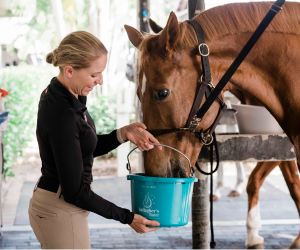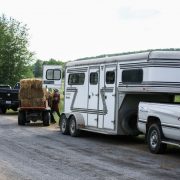Savvy OTTB Buyer: What Matters Most When Buying A Horse Off The Track

Heels Down Happy Hour podcast host and professional eventer, Jessica Payne, shared some top-level tips on what matters most when considering a Thoroughbred off-the-track as your next sport-horse purchase.
Often times, racehorses that come straight from the track won’t pass a pre-purchase exam with flying colors. So it’s good to know going in to the situation which blemishes or ailments you can live with, and which you can’t.
“Knowledge is everything,” Jess explained. “You’ll want to know what you’re dealing with.”
Evaluating Conformation
To start, a buyer should have some general knowledge of horse conformation. This will play a vital role in evaluating horses on the racetrack and what kind of second career they could excel in.
Listen to Heels Down Happy Hour Podcast 41: How To Ride Through Hardcore Anxiety
“For me, I don’t want something super long in the back. They could end up having back issues and are harder to compress,” Jess explained. “I like a shorter back but I don’t mind if they have a longer neck, because that does help with jumping.”
Jess said she also prefers her Thoroughbreds to be built more uphill.
“You don’t want them built down, with their butt higher than their withers. Make sure they look the part,” she described.
“You want their legs to be straight. If they are put together well, that’s a good thing. You want their feet to be similar, not different shapes or sizes,” she continued.
Know What You Can Live With
No animal is perfect, especially one that already spent years performing in another athletic career. So Jess recommends going in knowing what minor ailments or issues you can manage.
“When you talk about what they can live with, their feet can be a little flatter if you have a good farrier,” she suggested.
“If they have some (bone) spurs that don’t bother them or could remove them very easily,” is another example she cited.
Like This Story? Try: Even George Morris Does It – Dressage In A Jumping Saddle
“I’m more interested in how they flex. Are they flexing three-legged lame? Then probably steer clear of it. Their flexions tell you something and X-rays tells you something,” she explained.
Always Call The Vet Out
Even if the horse is free, do a basic vetting, Jess said.
“You want to make sure there’s no pre-existing conditions. Like a strained tendon, you don’t want any of that. Or anything in their ligaments. A lot of that is going to be a maintenance nightmare,” she put it bluntly. ” Find a vet that you trust to do a basic pre-purchase.”
Jess bought her now 22-year-old Thoroughbred, High Society III, knowing he had “an ugly ankle”. The bay gelding had raced in Australia before Jess purchased him and campaigned him over the years at the Advanced level.
“His superficial was four-times the size of what it should look like on an ultrasound,” Jess said. “He’d gotten wrapped up in wire. But my vet said, ‘you’re going to have a million problems with this horse, but this won’t be one of them.'”
Jess trusted her vet. And he was right.
“The ankle never bothered him,” she said. “He’s 22 now, sound and competing with one of our clients.”


